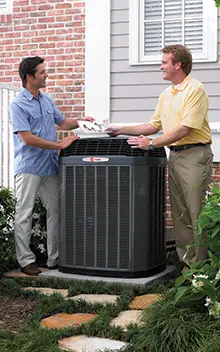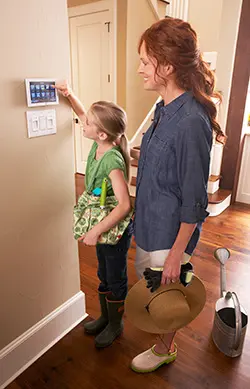Explore Our Installation Services & Maintenance Resources
Guarantee
New Equipment
We provide all new equipment we sell, install, and start-up with a 1-year free parts and labor warranty, beginning from the day the equipment was started and operated.
All our compressors carry a 5- or 10-year warranty. After the first year, any labor, freight, and materials necessary for installation are not covered.
Our new equipment warranty does not cover cleaning, damage from non-equipment-related items, abuse, or filter servicing.
Replacement parts carry a 1-year warranty if the part is installed by an Air Conditioning Specialists employee. The service associated with installing the part also carries a 1-year free labor warranty. An additional 4-year warranty may be purchased with a replacement compressor.

Service
All of our service work carries a 1-year warranty unless specifically denied on the associated invoice. This warranty applies only to service performed by an Air Conditioning Specialists employee and when the service is performed as recommended by our personnel.
Condensate Water Leaks
Air Conditioning Specialists warranty on condensate water leaks for 72 hours. ACS is not responsible or liable for any prior, current, or consequential damages, mold, or sickness caused by said leaks. This includes all servicing, cleaning, and new equipment installation.

Complete Energy Analysis
If your home is older than 10 years, the City of Austin encourages you to sign up for a complete energy analysis to determine its energy efficiency by a contractor of HVAC in Austin. Depending on the improvements suggested, Austin Energy will rebate up to 20 percent of the cost (up to $1400).
The Home Performance with Energy Star rebates covers air conditioner (13 SEER or greater) improvements, duct repair and sealing, adding additional attic insulation, solar screens, caulking, and weatherstripping.
The Home Performance with Energy Star program is designed to help you lower your electric bills, improve your home’s overall comfort level, and better the air quality. Besides the rebates, a variety of loan programs are also available to qualifying applicants, as well as “package” upgrade deals.
As a registered participating company with the City of Austin Home Performance with Energy Star, we can perform both the initial energy analysis and the subsequent upgrades.
AC Terms And Definitions
We’ve listed some common HVAC industry terms and their definitions below. At Air Conditioning Specialists, we believe AC repair in the Austin, TX area should be as convenient as possible. That's why we put together this handy list. If you don’t see what you’re looking for or need more information, contact us.
AFUE (Annual Fuel Utilization Efficiency) — A measure of a gas furnace’s efficiency in converting fuel to energy. The higher the rating, the more efficient the unit. For example, A rating of 90 means that approximately 90 percent of the fuel is used to provide warmth to your home, while the remaining 10 percent escapes as exhaust.
BTU (British Thermal Unit) — The heat necessary to raise the temperature of 1 pound of water 1 degree Fahrenheit. In your home, BTUs measure 1) the heat is given off when fuel is burned for heating and 2) the heat that is extracted from your home during cooling.

CFM (Cubic Feet per Minute) — A standard measurement of airflow. A typical HVAC system requires 400 CFM per ton of air conditioning.
Capacity — The output or producing ability of a piece of cooling or heating equipment. Cooling and heating capacities are measured in BTUs.
Comfort-R™ Airflow System — An exclusive feature of a high-efficiency home comfort system from Trane. This method of ramping airflow gives you greater humidity control in cooling and provides warmer air during heating start-up.
Compressor — The heart of an air conditioning or heat pump system. Located outside, the compressor pumps refrigerant into the home in order to meet the cooling requirements of the system.
Condenser Coil or Outdoor Coil — In an air conditioner, the coil dissipates heat from the refrigerant, changing the refrigerant from vapor to liquid. In a heat pump system, it absorbs heat from the outside air.
Damper — Found in ductwork, the damper is a movable plate that opens and closes to control airflow. Dampers can be used to balance airflow in a duct system. They are also used in zoning to regulate airflow to certain rooms.
Ductwork — Pipes or channels that carry air throughout your home. In a home comfort system, ductwork is critical to performance — as critical as the equipment itself, in fact.
Evaporator Coil or Indoor Coil — Located inside your home in the indoor unit, this is where the refrigerant evaporates as it absorbs heat from the air that passes over the coil. Along with the condenser coil, it forms the 2 halves of your air conditioning system.
Gas Furnace Heat Exchanger — Located in the furnace, the heat exchanger transfers heat to the surrounding air, which is then pumped throughout your home.
HVAC (Heating, Ventilation, and Air Conditioning) — The general industry term encompasses a variety of home comfort equipment, including air conditioners, furnaces, thermostats, filters, ductwork, and filters.
HSPF (Heating Seasonal Performance Factor) — This rating is used in measuring the heating efficiency of a heat pump. The higher the number, the more efficient the unit.
Package Unit — A heating and cooling system contained in one outdoor unit. A package unit is typically installed either beside or on top of the home or sometimes in the attic.
Refrigerant — A chemical that produces a refrigerating effect while expanding and vaporizing. Most residential air conditioning systems contain R-22 refrigerant. R-22 is regulated by international controls under the Montreal Protocol and in the United States by the Environmental Protection Agency. It is scheduled to be in production until the year 2020. It’s used in approximately 95% of air conditioning equipment manufactured in the U.S. today.
SEER (Seasonal Energy Efficiency Ratio) — Similar to a car’s miles per gallon measure of fuel efficiency, the SEER is a measure of cooling efficiency for air conditioners and heat pumps. The higher the SEER, the more energy efficient the unit. The government’s minimum SEER rating is 10.
Split System — The combination of an outdoor unit (air conditioner or heat pump) with an indoor unit (furnace or air handler). Split systems must be matched for optimum efficiency.
Thermostat — A thermostat consists of a series of sensors and relays that monitor and automatically control the functions of a heating and cooling system.
Ton — A unit of measurement used for determining cooling capacity. One ton is the equivalent of 12,000 BTUs per hour.
Zoning — A method of dividing a home into different comfort zones so each zone can be independently controlled depending on use and need.
